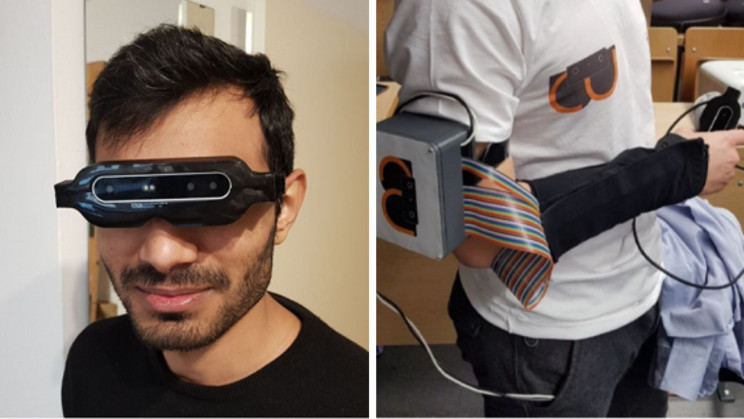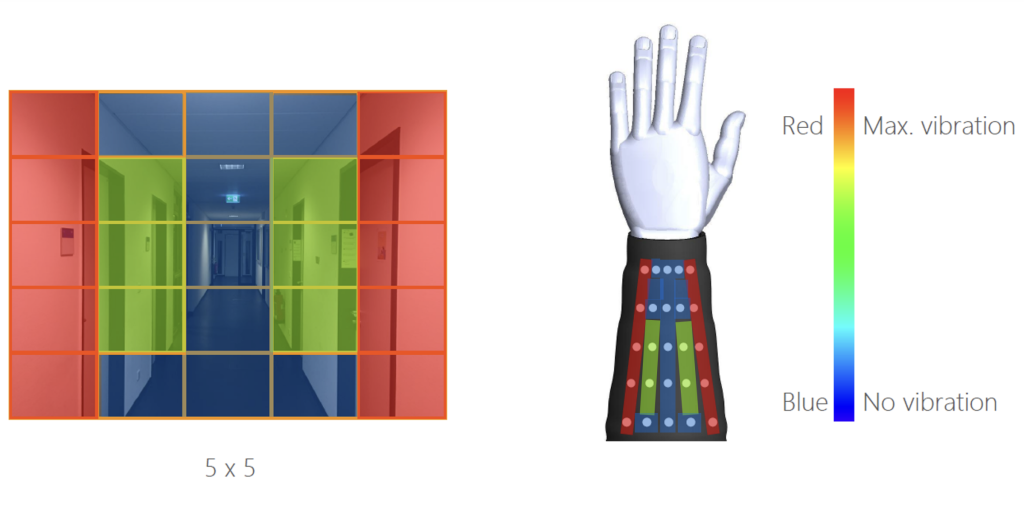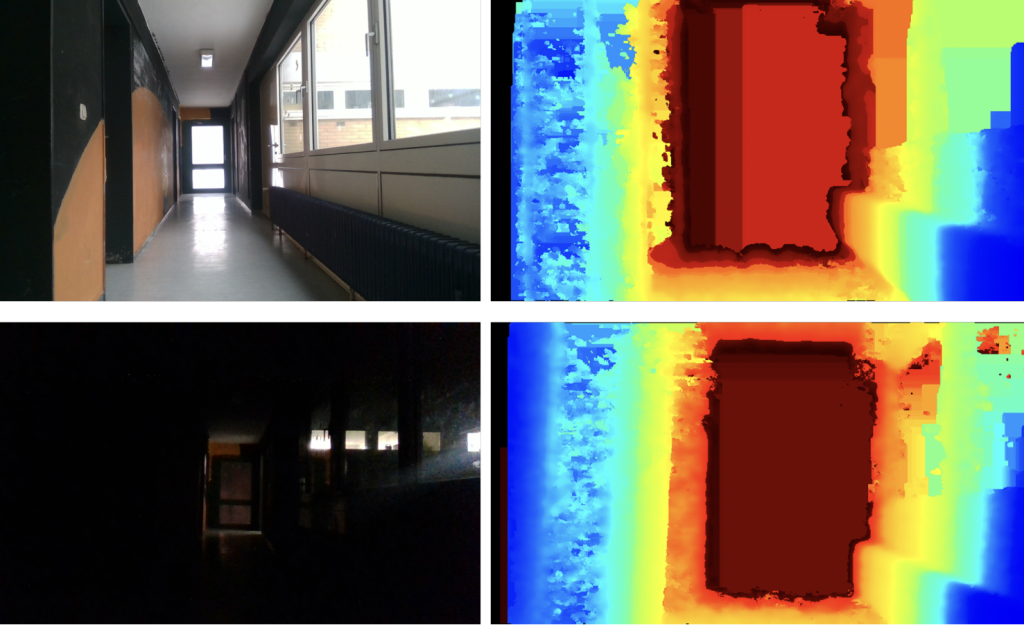Researchers at the Technical University of Munich (TUM) have developed a novel infrared (IR) goggle-based setup with the potential to enable the visually impaired to effortlessly navigate obstacles in their daily lives.
Composed of two IR cameras on an FDM-printed frame, the team’s glasses relay data about a user’s surroundings to a motor-padded sleeve, which tells them how far objects are away via haptic feedback. In future, the system could replace the traditional walking cane, allowing blind people to detect more distant obstacles, carry out new two-handed tasks and traverse with greater independence.
“Our solution is low-cost, lightweight and designed for indoor as well as outdoor usage,” the engineers explained in their paper. “The haptic feedback sleeve does not interfere with the user’s sense of hearing, which is extensively used by the visually impaired. It also takes away stigmatization, allowing blind people to add a useful tool for more independence, safety and confidence.”

Modernizing the walking cane
Whether they be developed through injury, infection, old age or refractive errors, visual impairments affect at least 2.2 billion people around the world, with 40 million of those afflicted being completely blind. Yet, despite the scale of the problem revealed by these World Health Organization (WHO) figures, as well as continued medical advances, most blind people still rely on canes for daily navigation.
While such aids provide users with a reasonable idea of their immediate surroundings, they have obvious detection distance limitations, and their efficacy on elevated surfaces such as stairs remains mixed. Similarly, walking canes can be difficult to use during snowy weather conditions, which mask the path ahead and often leave blind people requiring help, limiting their day-to-day independence.
To get around these restraints, various electronic travel aids or ‘ETAs’ have been developed that effectively guide wearers, by providing them with either an acoustic or haptic ‘map’ of their environment. However, according to the TUM team, many existing ETAs require lengthy training to master and interfere with blind people’s other senses, while often facing a trade off between resolution and lightness.

Enabling blind people to ‘see’
As opposed to many conventional haptic ETAs, which rely on chest-worn Microsoft Kinect sensors, the researchers chose to base theirs around a pair of Intel RealSense D415 camera-mounted glasses. In the team’s setup, the data obtained via these cameras, which are able to capture images at a pixel resolution of up to 1280 x 720, is fed into a stretchable motor-laden fabric, designed to be worn on the forearm.
In turn, this ‘haptic sleeve,’ featuring 25 sewn-in vibration motors can then be programmed so that its vibration intensity increases as wearers get closer to any obstacles. To make this possible, the engineers found that they initially had to ‘downsample’ the data gathered via their 3D printed goggles into a 5×5 array, that allowed them to vary the voltage of each respective motor of their novel device.
Once they’d mapped their eye and arm-mounted setup, the team went on to subject it to both haptic patterning tests and an obstacle course, littered with walkways, doors and potential hindrances. In the former, the system was able to achieve a near-perfect accuracy of 98.6%, but in the latter, only four out of five test subjects made it through unscathed, showing that it still requires user training.
Impressively though, the researchers’ devices did manage to consistently sense obstacles indoors at distances of up to 3 meters, meaning that its capabilities exceed even the longest walking canes, while it also proved able to operate outdoors in complete darkness, thus it could even provide users with better night perception than the perfectly-sighted.
Although the engineers admit that the system’s efficacy somewhat depends on the “muscularity of the forearm region,” they say that users have still been able to reduce their course times by 53% during testing. With further R&D, including the addition of a voice control system, the TUM team therefore believe that their setup could represent an accessible new way of giving “more independence to the visually impaired.”

AM in tackling ocular impairments
Instead of seeking to treat the problems caused by blindness, researchers at several other universities are now seeking to address the ailment at its source, by developing bioprinted corneal transplants. At Marmara University, for instance, scientists have managed to create novel PVA-chitosan constructs, with the light-bending properties of real corneas.
Likewise, a team based at Florida A&M University reported achieving the high-throughput printing of human corneas back in June 2019. Carried out using a CELLINK BIO X 3D bioprinter, it was thought at the time that the project would lead to advances in the treatment of corneal conditions and other eye-related ailments.
In more recent applications, 3D printing has also been deployed in practise by clinicians at London’s Moorfields Eye Hospital. Using the technology, a team there was able to produce the world’s first 3D printed prosthetic eye and fit it for local man Steve Verze, in a way that dramatically reduced the time he had to wait for a realistic ocular replica.
The researchers’ findings are detailed in their paper titled “Obstacle avoidance for blind people using a 3D camera and a haptic feedback sleeve,” which was co-authored by Manuel Zahn and Armaghan Ahmad Khan.
To stay up to date with the latest 3D printing news, don’t forget to subscribe to the 3D Printing Industry newsletter or follow us on Twitter or liking our page on Facebook.
For a deeper dive into additive manufacturing, you can now subscribe to our Youtube channel, featuring discussion, debriefs, and shots of 3D printing in-action.
Are you looking for a job in the additive manufacturing industry? Visit 3D Printing Jobs for a selection of roles in the industry.
Featured image shows one of the researchers wearing their prototype 3D printed IR goggles. Photo via Manuel Zahn and Armaghan Ahmad Khan.



